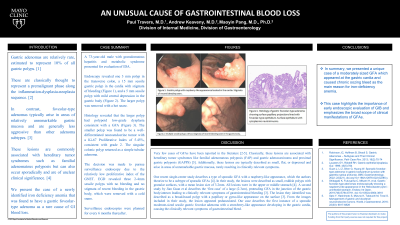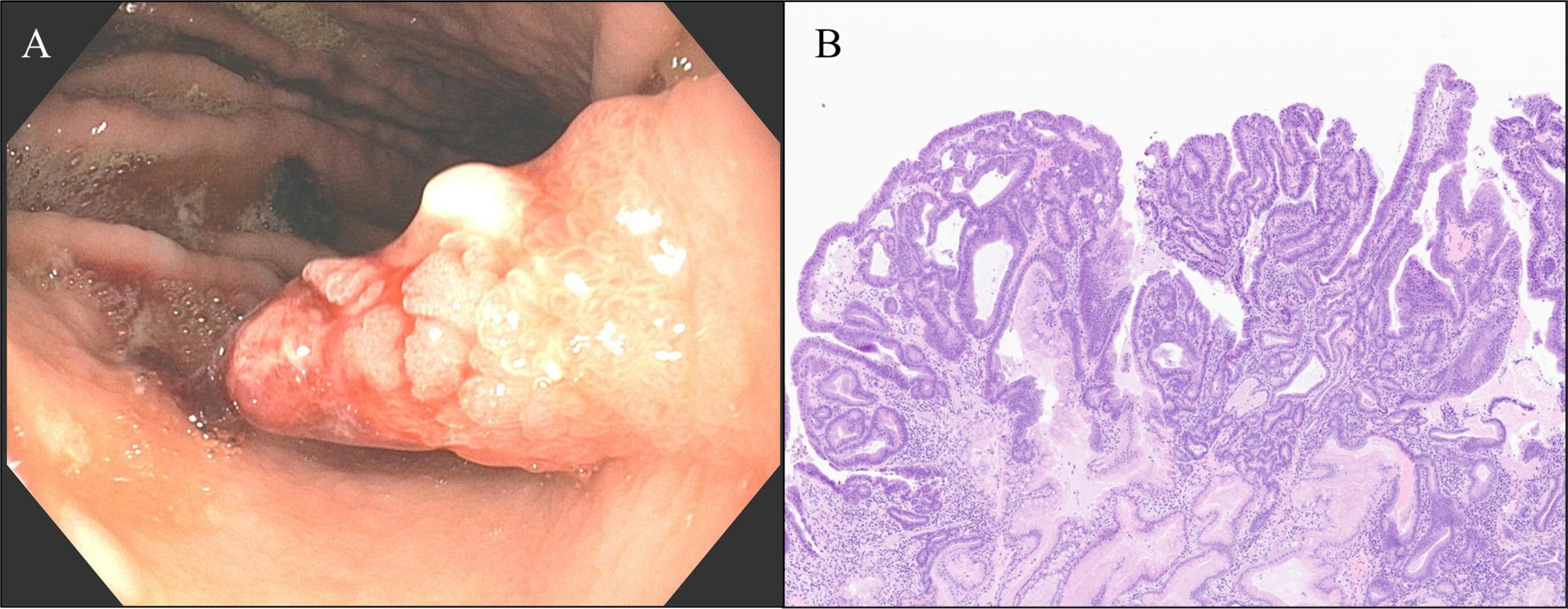Back


Poster Session A - Sunday Afternoon
Category: GI Bleeding
A0310 - An Unusual Cause of GI Blood Loss
Sunday, October 23, 2022
5:00 PM – 7:00 PM ET
Location: Crown Ballroom

Has Audio

Paul Travers, MD
Mayo Clinic
Jacksonville, FL
Presenting Author(s)
Paul Travers, MD1, Maoyin Pang, MD, PhD2, Krishna Murli, MD2
1Mayo Clinic, Jacksonville, FL; 2Mayo Clinic Florida, Jacksonville, FL
Introduction: Gastric adenomas are relatively rare, estimated to represent 10% of all gastric polyps. These typically arise in the setting of chronic mucosal inflammation and are thought to represent a premalignant phase along the inflammation-dysplasia-neoplasia sequence during which intervention can prevent or minimize progression to carcinoma. Foveolar-type adenomas, however, typically arise in areas of relatively unremarkable gastric mucosa and are generally less aggressive than other adenoma subtypes. These lesions are commonly associated with hereditary tumor syndromes such as familial adenomatous polyposis but can also occur sporadically. We present a case of newly identified iron deficiency anemia (IDA) that was found to have a gastric foveolar-type adenoma as a rare cause of GI blood loss.
Case Description/Methods: A 73-year-old male with granulomatous hepatitis and metabolic syndrome presented for evaluation of IDA. Colonoscopy was notable for one 3 mm polyp in the transverse colon. EGD revealed a 15 mm gastric polyp with a raspberry appearance in the cardia with stigmata of bleeding and a 5 mm sessile polyp with mild central depression in the gastric body. Histology revealed that the larger polyp had low-grade polypoid dysplasia consistent with a foveolar-type adenoma. The smaller polyp was found to be a well-differentiated neuroendocrine tumor. The singular colonic polyp returned as a simple tubular adenoma. A repeat EGD was performed 6 months after polypectomies with no residual lesions. It was determined that the foveolar adenoma located at the cardia was the source of IDA, while the neuroendocrine tumor was just an incidental finding.
Discussion: While sporadic foveolar-type adenomas and GNET’s in helicobacter pylori- uninfected stomachs are infrequently encountered in clinical practice, their incidence is continuing to rise, due to the increased use of upper endoscopy as a diagnostic tool. Although foveolar-type adenomas are usually benign, this case had low-grade dysplasia and chronic oozing blood as the main reason for iron-deficiency anemia. In addition, this patient also needed prompt evaluation regarding the management of GNET as angioinvasion and metastasis are common. Although these lesions are typically identified incidentally, it is important for the gastroenterologist to keep them in the differential for common complaints such as gastrointestinal bleeding (GIB). This case highlights the importance of early endoscopic evaluation of GIB.

Disclosures:
Paul Travers, MD1, Maoyin Pang, MD, PhD2, Krishna Murli, MD2. A0310 - An Unusual Cause of GI Blood Loss, ACG 2022 Annual Scientific Meeting Abstracts. Charlotte, NC: American College of Gastroenterology.
1Mayo Clinic, Jacksonville, FL; 2Mayo Clinic Florida, Jacksonville, FL
Introduction: Gastric adenomas are relatively rare, estimated to represent 10% of all gastric polyps. These typically arise in the setting of chronic mucosal inflammation and are thought to represent a premalignant phase along the inflammation-dysplasia-neoplasia sequence during which intervention can prevent or minimize progression to carcinoma. Foveolar-type adenomas, however, typically arise in areas of relatively unremarkable gastric mucosa and are generally less aggressive than other adenoma subtypes. These lesions are commonly associated with hereditary tumor syndromes such as familial adenomatous polyposis but can also occur sporadically. We present a case of newly identified iron deficiency anemia (IDA) that was found to have a gastric foveolar-type adenoma as a rare cause of GI blood loss.
Case Description/Methods: A 73-year-old male with granulomatous hepatitis and metabolic syndrome presented for evaluation of IDA. Colonoscopy was notable for one 3 mm polyp in the transverse colon. EGD revealed a 15 mm gastric polyp with a raspberry appearance in the cardia with stigmata of bleeding and a 5 mm sessile polyp with mild central depression in the gastric body. Histology revealed that the larger polyp had low-grade polypoid dysplasia consistent with a foveolar-type adenoma. The smaller polyp was found to be a well-differentiated neuroendocrine tumor. The singular colonic polyp returned as a simple tubular adenoma. A repeat EGD was performed 6 months after polypectomies with no residual lesions. It was determined that the foveolar adenoma located at the cardia was the source of IDA, while the neuroendocrine tumor was just an incidental finding.
Discussion: While sporadic foveolar-type adenomas and GNET’s in helicobacter pylori- uninfected stomachs are infrequently encountered in clinical practice, their incidence is continuing to rise, due to the increased use of upper endoscopy as a diagnostic tool. Although foveolar-type adenomas are usually benign, this case had low-grade dysplasia and chronic oozing blood as the main reason for iron-deficiency anemia. In addition, this patient also needed prompt evaluation regarding the management of GNET as angioinvasion and metastasis are common. Although these lesions are typically identified incidentally, it is important for the gastroenterologist to keep them in the differential for common complaints such as gastrointestinal bleeding (GIB). This case highlights the importance of early endoscopic evaluation of GIB.

Figure: A. Gastric polyp with raspberry-like appearance located in the cardia. Stigmata of recent bleeding seen.
B. Histology of gastric foveolar-type adenoma showing surface papillary projections lined with foveolar-type epithelium. Surface epithelium with cytoplasmic neutral mucins.
B. Histology of gastric foveolar-type adenoma showing surface papillary projections lined with foveolar-type epithelium. Surface epithelium with cytoplasmic neutral mucins.
Disclosures:
Paul Travers indicated no relevant financial relationships.
Maoyin Pang indicated no relevant financial relationships.
Krishna Murli indicated no relevant financial relationships.
Paul Travers, MD1, Maoyin Pang, MD, PhD2, Krishna Murli, MD2. A0310 - An Unusual Cause of GI Blood Loss, ACG 2022 Annual Scientific Meeting Abstracts. Charlotte, NC: American College of Gastroenterology.
